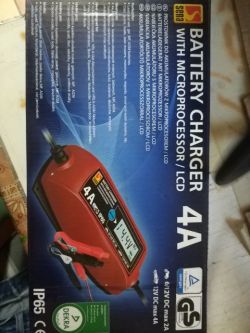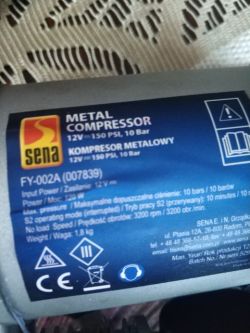Hello,
at the beginning, I inform you that I am a layman when it comes to matters related to electrics and electronics, I am a complete layman, so I will ask for possible explanations of the problem "like a cow in between".
I have a car compressor with the following parameters:
DC 12 - 13.5V
Max Current: 14 Amp
Marking from the nameplate.
I would like to plug it into an electrical outlet. I know that I have to use a power supply or possibly a rectifier. The charger has a neighbor - I can borrow it. It is not a firm, but a simple one made by him in a cottage way. He measured the value of the current consumption on this rectifier (without load) and it came out: 20 V and 18 A.
Can a compressor be connected to this rectifier - I would not like to burn it?
If so, tell me where on the compressor plug (the cigarette lighter socket) is +: is it on the pin in the middle or on the sides?
Ultimately, I would like to build a power supply for it. And here's a request if any of you have any relatively detailed description and a list of parts to build something like that. It can also be a wiring diagram - I hope my neighbor will help me. I know you will need a transformer and the so-called Gretz system. Anything else? How to build something like this? I have a so-called transformer trioid (that's what it's probably called) from halogen lighting, but I don't know its exact parameters. Can you check them somehow?
It was connected to 4 halogen lamps of 35 W 12V.
Please help.
greetings
at the beginning, I inform you that I am a layman when it comes to matters related to electrics and electronics, I am a complete layman, so I will ask for possible explanations of the problem "like a cow in between".
I have a car compressor with the following parameters:
DC 12 - 13.5V
Max Current: 14 Amp
Marking from the nameplate.
I would like to plug it into an electrical outlet. I know that I have to use a power supply or possibly a rectifier. The charger has a neighbor - I can borrow it. It is not a firm, but a simple one made by him in a cottage way. He measured the value of the current consumption on this rectifier (without load) and it came out: 20 V and 18 A.
Can a compressor be connected to this rectifier - I would not like to burn it?
If so, tell me where on the compressor plug (the cigarette lighter socket) is +: is it on the pin in the middle or on the sides?
Ultimately, I would like to build a power supply for it. And here's a request if any of you have any relatively detailed description and a list of parts to build something like that. It can also be a wiring diagram - I hope my neighbor will help me. I know you will need a transformer and the so-called Gretz system. Anything else? How to build something like this? I have a so-called transformer trioid (that's what it's probably called) from halogen lighting, but I don't know its exact parameters. Can you check them somehow?
It was connected to 4 halogen lamps of 35 W 12V.
Please help.
greetings




